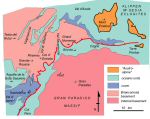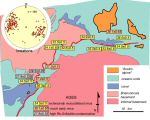 Kinematic and geochronological investigations of the Entrelor Shear Zone
Kinematic and geochronological investigations of the Entrelor Shear Zone Evolution of the metamorphic western Alps
 Kinematic and geochronological investigations of the Entrelor Shear Zone
Kinematic and geochronological investigations of the Entrelor Shear Zone The Entrelor Shear Zone is a major tectonic contact in the western Alps. It dips westwards and carries so-called "Brianconnais" basement and cover units (rocks of the European passive margin) onto metasediments and meta-basic rocks assumed to be derived from the Tethys sea floor. These Tethyan units rest in turn tectonically upon an "internal basement massif" ( Gran Paradiso). Both of these units beneath the Entrelor shear zone, preserved local eclogites. The Brianconnais units show no evidence of having been buried to such great depths. So the Entrelor Shear Zone places "lower grade" on "higher grade" metamorphic rocks. But it also places older (basement) onto younger (oceanic cover). The structural studies presented here (based on Butler & Freeman 1996) show clear top-to-east kinematics at greenschist facies ( syn-Entrelor) conditions. Classically the Entrelor Shear Zone can be interpreted as a backthrust. The apparent "omission" of metamorphic "stratigraphy" (lower on higher grade) may be explained if the high grade rocks were first emplaced onto the Brianconnais and then breached from below. Indeed eclogitic Tethyan (and Austroalpine) units do this. However, it remains unclear if the Entrelor shear zone was, on a crustal scale, contractional or extensional at the time of movement. Solving this conundrum requires information on the orientation of horizontal datum horizons at the timing of the specific deformation - a difficult thing to assess in the internal parts of mountain belts.
Choose from the figures below (click on images for a larger version).
 A
simplified map of the Entrelor shear zone, with place names indicated.
A
simplified map of the Entrelor shear zone, with place names indicated.
 View
of the so-called "Digitation de l'Iseran", looking north from Col Pers. Brianconnais carbonates
(peaks on L) are carried onto oceanic units (darker, lower hill on R: east). Note the westward dip of
the units. About 1 km of topography is visible.
View
of the so-called "Digitation de l'Iseran", looking north from Col Pers. Brianconnais carbonates
(peaks on L) are carried onto oceanic units (darker, lower hill on R: east). Note the westward dip of
the units. About 1 km of topography is visible.
 The
Entrelor Shear Zone at its type area (just above the eponymous col). The geologists are standing on
the thrust with basement above and oceanic metasediments below.
The
Entrelor Shear Zone at its type area (just above the eponymous col). The geologists are standing on
the thrust with basement above and oceanic metasediments below.
 The prominent stretching lineation developed on the Entrelor shear zone (here seen in its footwall,
looking down on the foliation) defined by actinolite/chlorite/epidote aggregates.
The prominent stretching lineation developed on the Entrelor shear zone (here seen in its footwall,
looking down on the foliation) defined by actinolite/chlorite/epidote aggregates.
 S-C fabrics developed in calcschists in the footwall to the Entrelor shear zone. Seen here looking
north, the shear sense is top-E.
S-C fabrics developed in calcschists in the footwall to the Entrelor shear zone. Seen here looking
north, the shear sense is top-E.
 Asymmetric boudinage developed in the footwall to the Entrelor Shear Zone, seen here looking N. The
asymmetry implies top-east shear. The minor shears here are defined by actinolite-chlorite assemblages
( greenschist facies) although the main boudins (of metagabbro) preserved eclogitic assemblages.
John Wheeler for scale.
Asymmetric boudinage developed in the footwall to the Entrelor Shear Zone, seen here looking N. The
asymmetry implies top-east shear. The minor shears here are defined by actinolite-chlorite assemblages
( greenschist facies) although the main boudins (of metagabbro) preserved eclogitic assemblages.
John Wheeler for scale.
 Rb-Sr deformation age data for the Entrelor Shear Zone (Freeman et al. 1997), together with greenschist
mineral lineations for the shear zone.
Rb-Sr deformation age data for the Entrelor Shear Zone (Freeman et al. 1997), together with greenschist
mineral lineations for the shear zone.
Further information on the Entrelor shear zone may be found in the following papers:
Butler, R W.H. & Freeman, S.J. 1996. Can crustal extension be distinguished from thrusting in the internal parts of mountain belts? An example from the Entrelor shear zone, western Alps.J. Struct. Geol. 18 , 909-923.
Freeman, S., Inger, S., Butler, R.W.H. & Cliff, R.A. 1997. Dating deformation using Rb-Sr in white mica; greenschist facies deformation ages from the Entrelor shear zone, Italian Alps. Tectonics 16, 57-76.
Butler, R.W.H. & Freeman, S. 1999. Dating Alpine shear zones - using Rb -Sr geochronology on white mica to gain deformation ages in the western Alps.In: 3 rd Workshop on Alpine Geological Studies (ed. G. Gosso, F. Jadoul, M. Sella & M.I. Spalla) Memorie di Scienze Geologiche, Padova, 51, 177-189.
Title image: Looking east onto the peak of Grivola. The col to its left (N) contains the Entrelor shear zone, with the basement unit (Grand Nomenon) above. The contact is picked out by a prominent streak of cargneule (gypsum residue). The right col (S) is on the contact between the oceanic units and the Gran Paradiso massif. The peak of Grivola contains prominent bands of green ( metaophiolite) and beige (oceanic metasediment). About 2 km of topography is visible.
|| Alpine Tectonics || Evolution of the metamorphic western Alps ||